Related Research Articles

The 1968 United States presidential election was the 46th quadrennial presidential election, held on Tuesday, November 5, 1968. The Republican nominee, former vice president Richard Nixon, defeated both the Democratic nominee, incumbent vice president Hubert Humphrey, and the American Independent Party nominee, former Alabama governor George Wallace. This was the last election until 1988 in which the incumbent president was not on the ballot. This was also the last election where a third-party candidate received an electoral vote.
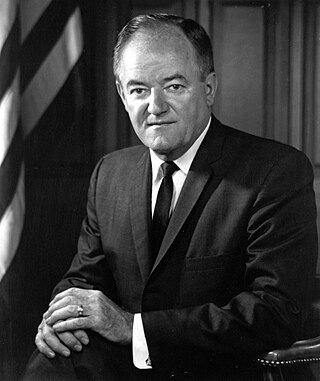
Hubert Horatio Humphrey Jr. was an American politician and statesman who served as the 38th vice president of the United States from 1965 to 1969. He twice served in the United States Senate, representing Minnesota from 1949 to 1964 and 1971 to 1978. As a senator he was a major leader of modern liberalism in the United States. As President Lyndon B. Johnson's vice president, he supported the controversial Vietnam War. An intensely divided Democratic Party nominated him in the 1968 presidential election, which he lost to Republican nominee Richard Nixon.

Lyndon Baines Johnson, often referred to by his initials LBJ, was an American politician who served as the 36th president of the United States from 1963 to 1969. He became president after the assassination of John F. Kennedy, under whom he had served as the 37th vice president from 1961 to 1963. A Democrat from Texas, Johnson also served as a U.S. representative and U.S. senator.
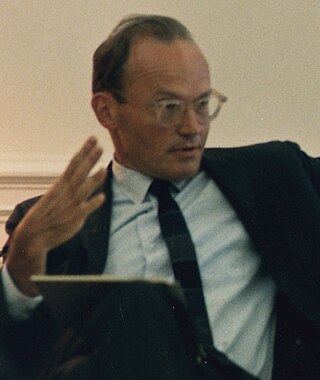
McGeorge "Mac" Bundy was an American academic who served as the U.S. National Security Advisor to Presidents John F. Kennedy and Lyndon B. Johnson from 1961 through 1966. He was president of the Ford Foundation from 1966 through 1979. Despite his career as a foreign-policy intellectual, educator, and philanthropist, he is best remembered as one of the chief architects of the United States' escalation of the Vietnam War during the Kennedy and Johnson administrations.
This section of the timeline of United States history concerns events from 1950 to 1969.
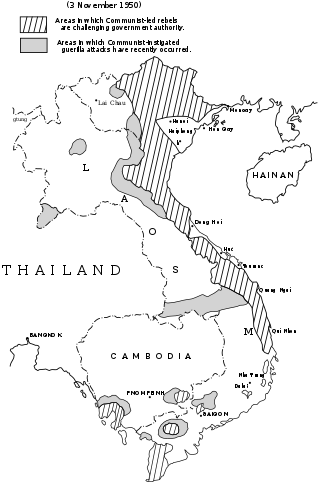
The Pentagon Papers, officially titled The History of U.S. Decision-Making in Vietnam, 1945–1968, is a United States Department of Defense history of the United States' political and military involvement in Vietnam from 1945 to 1968. Released by Daniel Ellsberg, who had worked on the study, they were first brought to the attention of the public on the front page of The New York Times in 1971. A 1996 article in The New York Times said that the Pentagon Papers had demonstrated, among other things, that Lyndon B. Johnson's administration had "systematically lied, not only to the public but also to Congress."

The history of the United States from 1964 to 1980 includes the climax and end of the Civil Rights Movement; the escalation and ending of the Vietnam War; the drama of a generational revolt with its sexual freedoms and use of drugs; and the continuation of the Cold War, with its Space Race to put a man on the Moon. The economy was prosperous and expanding until the recession of 1969–70, then faltered under new foreign competition and the 1973 oil crisis. American society was polarized by the ultimately futile war and by antiwar and antidraft protests, as well as by the shocking Watergate affair, which revealed corruption and gross misconduct at the highest level of government. By 1980 and the seizure of the American Embassy in Iran, including a failed rescue attempt by U.S. armed forces, there was a growing sense of national malaise.

John Bowden Connally Jr. was an American politician who served as the 39th governor of Texas (1963–1969) and as the 61st United States Secretary of the Treasury (1971–1972). He began his career as a Democrat and later became a Republican in 1973.
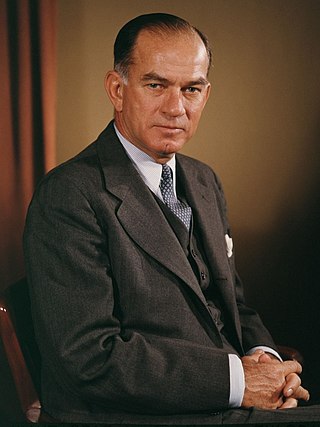
James William Fulbright was an American politician, academic, and statesman who represented Arkansas in the United States Senate from 1945 until his resignation in 1974. As of 2023, Fulbright is the longest serving chairman in the history of the United States Senate Committee on Foreign Relations. He is best known for his strong multilateralist positions on international issues, opposition to American involvement in the Vietnam War, and the creation of the international fellowship program bearing his name, the Fulbright Program.

George Wildman Ball was an American diplomat and banker. He served in the management of the US State Department from 1961 to 1966 and is remembered by most as the only cabinet member of Presidents John F. Kennedy and Lyndon B. Johnson who was a major dissenter against the escalation of the Vietnam War. Ball advised against deploying U.S. combat forces, as he believed it would lead the United States into an unwinnable war and result in a prolonged conflict. Instead, he argued that the United States should prioritize allocating its resources to Europe rather than engaging in expensive military ventures. He refused to publicize his doubts. He helped determine American policy regarding trade expansion, Congo, the Multilateral Force, de Gaulle's France, Israel and the rest of the Middle East, and the Iranian Revolution.
In the United States, during the Cold War, the missile gap was the perceived superiority of the number and power of the USSR's missiles in comparison with those of the U.S.. The gap in the ballistic missile arsenals did not exist except in exaggerated estimates, made by the Gaither Committee in 1957 and in United States Air Force (USAF) figures. Even the contradictory CIA figures for the USSR's weaponry, which showed a clear advantage for the US, were far above the actual count. Like the bomber gap of only a few years earlier, it was soon demonstrated that the gap was entirely fictional.
George Edward Reedy was the tenth White House Press Secretary, and served under President Lyndon B. Johnson from 1964 to 1965.
United States involvement in the Vietnam War began shortly after the end of World War II in Asia, first in an extremely limited capacity and escalating over a period of 20 years. The U.S. military presence peaked in April 1969, with 543,000 American combat troops stationed in Vietnam. By the conclusion of the United States's involvement in 1973, over 3.1 million Americans had been stationed in Vietnam.
The Lyndon B. Johnson bibliography includes major books and articles about President Lyndon B. Johnson, his life, and presidential administration. Kent B. Germany in his review of the historiography noted in 2009 that Johnson has been the subject of 250 Ph.D. dissertations, well over one hundred books, and many scholarly articles. The New York Times and the Washington Post published 7600 articles on him during his presidency. Only a select subgroup are listed here, chiefly those reviewed by the major scholarly journals.

Lyndon B. Johnson's tenure as the 36th president of the United States began on November 22, 1963, upon the assassination of president John F. Kennedy, and ended on January 20, 1969. Johnson had been vice president for 1,036 days when he succeeded to the presidency. Johnson, a Democrat from Texas, ran for and won a full four-year term in the 1964 presidential election, in which he defeated Republican nominee Barry Goldwater in a landslide. Johnson did not run for a second full term in the 1968 presidential election because of his low popularity. Johnson was succeeded by Republican Richard Nixon. His presidency marked the high tide of modern liberalism in the 20th century United States.
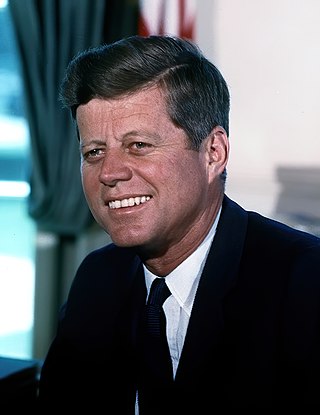
John F. Kennedy's tenure as the 35th president of the United States began with his inauguration on January 20, 1961, and ended with his assassination on November 22, 1963. Kennedy, a Democrat from Massachusetts, took office following his narrow victory over Republican incumbent vice president Richard Nixon in the 1960 presidential election. He was succeeded by Vice President Lyndon B. Johnson.

The 1968 presidential campaign of Hubert Humphrey began when Vice President of the United States Hubert Humphrey of Minnesota decided to seek the Democratic Party nomination for President of the United States following President Lyndon B. Johnson's announcement ending his own bid for the nomination. Johnson withdrew after an unexpectedly strong challenge from anti-Vietnam War presidential candidate, Senator Eugene McCarthy of Minnesota, in the early Democratic primaries. McCarthy, along with Senator Robert F. Kennedy of New York, became Humphrey's main opponents for the nomination. Their "new politics" contrasted with Humphrey's "old politics" as the increasingly unpopular Vietnam War intensified.

William Conrad Gibbons was an American historian and foreign policy expert.

The 1966 United States elections were held on November 8, 1966, and elected the members of the 90th United States Congress. The election was held in the middle of Democratic President Lyndon B. Johnson's second term, and during the Vietnam War. Johnson's Democrats lost forty-seven seats to the Republican Party in the House of Representatives. The Democrats also lost three seats in the U.S. Senate to the Republicans. Despite their losses, the Democrats retained control of both chambers of Congress. Republicans won a large victory in the gubernatorial elections, with a net gain of seven seats. This was the first election held after the passage of the Voting Rights Act of 1965, which led to a surge in African-American voter participation.

The United States foreign policy during the 1963-1969 presidency of Lyndon B. Johnson was dominated by the Vietnam War and the Cold War, a period of sustained geopolitical tension between the United States and the Soviet Union. Johnson took over after the Assassination of John F. Kennedy, while promising to keep Kennedy's policies and his team.
References
- ↑ Rouse, Robert (March 15, 2006). "Happy Anniversary to the first scheduled presidential press conference - 93 years young!". American Chronicle. Archived from the original on September 13, 2008. Retrieved November 12, 2008.
- 1 2 Hohmann, James (February 15, 2017). "The Daily 202: It's bigger than Flynn. New Russia revelations widen Trump's credibility gap". The Washington Post . Retrieved February 15, 2017.
- 1 2 "Credibility gap: Our view". USA Today . January 23, 2017. Retrieved February 15, 2017.
- ↑ Preble, Christopher A. (December 2003). "'Who Ever Believed in the "Missile Gap"?': John F. Kennedy and the Politics of National Security". Presidential Studies Quarterly. 33 (4): 801–826. doi:10.1046/j.0360-4918.2003.00085.x.
- ↑ Gunn, Bernard Grun (2005). The Timetables of History: A Horizontal Linkage of People and Events (4 ed.). Touchstone. ISBN 9780743270038.
- ↑ Associated Press article dated December 10, 1962, available online at NewspaperArchive.com.
- ↑ "1966 Year in Review". UPI. 1966. Retrieved April 16, 2013.
- ↑ Vietnam and America, edited by Marvin E. Gettleman, Jane Franklin, Marilyn Young and H. Bruce Franklin
- ↑ Reston, James (14 Feb 1965). "Washington: The Undeclared and Unexplained War". The New York Times .
- ↑ "Again, the Credibility Gap?". Time . April 5, 1971. Archived from the original on December 21, 2008.